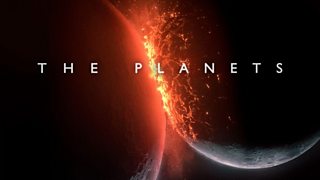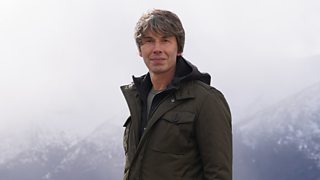Building The Planets

Take a look behind the scenes and find out how The Planets team brought the worlds of the Solar System to life.
by Series Director, Stephen Cooter
Βι¶ΉΤΌΕΔ Two’s The Planets features spectacular reconstructions of the most dramatic events in the lives of the worlds of our solar system - from the last rains on Venus, to waterfalls on ancient Mars. To create these sequences the production team combined the latest scientific findings, cutting edge computer-generated imagery, location filming and studio special effects.
This step-by-step guide reveals how you turn Iceland into Pluto, Jordan into Mars and even Lanzarote into Venus - from initial concept, to touchdown on an alien world.

Taken from the Curiosity Rover sequence from The Two Sisters, the image on the left is the original storyboard by Concept Artist John Kennedy. On the right, the final shot from the film, which combines location filming and computer-generated imagery.
From the violent formation of Saturn’s rings, to the beautiful water world that was once Mars, the series is filled with extraordinary moments that have never been seen before.Andrew Cohen, Executive Producer
Step One – Find the Stories
With over four billion years of history playing out on eight very different worlds – the first challenge was to identify which part of each planet’s life story to tell.
Working closely with our academic partners at , the research team used the latest planetary science research to draw up detailed timelines of each of the planets' histories.
From that we picked out the most dramatic events and key turning points in the lives of each world, to build into the scripts.
Step Two – Work out what they would have looked like
Once key moments had been identified and the scripts were close to being finalised, we begun to storyboard the computer-generated sequences – drawing out each one - shot by shot.
This process allowed the team to get a sense of what the sequences might look like and helped us decide prior to filming what shots we needed to tell the story and how those shots would be made.
During the early stages of the edit, the drawings were then combined with voiceover, music and filmed elements to begin to construct the sequences.
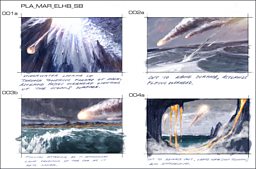
This is one of the original storyboards from the Late Heavy Bombardment sequence in The Two Sisters film. Shots very similar to 001, 002 and 004 were filmed and made it into the final film. Shot 003 was dropped at the storyboard stage.
We wanted to go beyond just seeing the planets from space. We wanted to land – and place our cameras on the surface.Gideon Bradshaw, Series Producer
Step Three - Find The Planets on Earth
The Late Heavy Bombardment sequence from the Two Sisters film depicts a cataclysmic event in the life of the early Solar System, during which over a third of Mars’s surface was obliterated.
For sequences like this, that take place largely on the surface of a planet, we decided the best approach would be to combine computer-generated imagery with live action photography.
And that meant finding places on Earth that closely matched places on other worlds in the Solar System – both today and in the distant past.
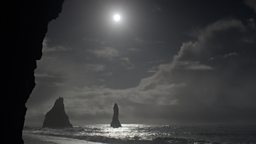
Location plate shot from the Late Heavy Bombardment sequence shot at Reynisfjara Beach near Vik, Iceland. This is shot 004 from the storyboard above.
the dramatic coastline of Southern Iceland, ( . . . ) provided an evocative setting for visualising one of the most violent periods in the Solar System’s history.Stephen Cooter, Series Director
In the case of the Late Heavy Bombardment sequence, we decided that the dramatic coastline of Southern Iceland, with its black sand and volcanic rock formations, provided an evocative setting for visualising one of the most violent periods in the Solar System’s history.
Elsewhere in the series, the volcanic landscapes of Lanzarote’s interior doubled as the surface of present day Venus and young Mercury, just after its formation.
Iceland’s glaciers and frozen lakes stood in for Saturn’s moon Eceladus, helped to recreate the Dwarf planet, Ceres, as it was 4.5 billion years ago and allowed us to journey to the surface of Pluto.
While Stromboli, an active volcano off the coast of Italy, became Jupiter’s volcanic moon Io and Jordan’s Wadi Rum became the surface of Mars…
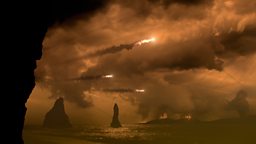
Shot 004 from the Late Heavy Bombardment sequence as it appears in the final programme.

The canyon at the foot of Iceland’s Dettifoss waterfall stood in for the icy surface of Mars 3.7 billion years ago, when volcanic activity created the largest waterfall the solar system has ever seen.

Lanzarote’s Montaña Colorada… transformed into Mercury four billion years ago, when active volcanoes and lava planes covered the young planet’s surface.
Step Four - Filming
With storyboards drawn and locations chosen, the teams went out into the field to capture the shots that would form the basis of the final computer-generated images. To give the shots a cinematic feel, portable tracks and jibs were used to move the camera and a drone used to get an aerial perspective.
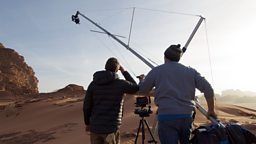
Director of Photography Julius Brighton and Camera Operator and Drone Pilot Olly Meacock rehearse a jib shot for the Curiosity Mars Rover sequence in Wadi Rum in the Jordanian desert.

The jib shot as captured by the camera, above, and below, as it appears in the final film with the Curiosity Rover added and the sky colour changed to match that on Mars.
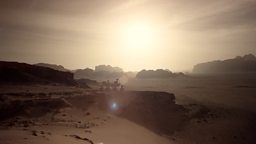
There were times while we were filming I felt we really could be standing on the surface of Mars.
Wadi Rum in Jordan is a truly other-worldly place. There were times while we were filming I felt we really could be standing on the surface of MarsStephen Cooter, Series Director
In addition, high-speed cameras were taken on location to shoot additional elements that would be prohibitively expensive to generate in CGI or difficult to recreate in the studio.
Raindrops falling onto the surface of the young Mars were filmed in Wadi Rum using a specialist ‘borescope’ lenses.
While Dettifoss and Godafoss waterfalls in Northern Iceland provided close-ups for ancient Mars’s Echus Chasma - the largest waterfall the Solar System has ever seen.
Step Five - Add Computer-Generated Imagery and Special Effects
Playground sand fired from an air cannon makes a great comet trail… a bath bomb filled with an explosive charge looks like a moon torn apart by gravity…Rob Harvey, Visual Effects Supervisor
Across the series there were some stories – and places - that simply couldn’t be filmed in any location on Earth.
Once you leave the rocky worlds of the inner Solar System behind, the Gas Giants Jupiter and Saturn, for instance, are vast swirling balls of gas – worlds about as different from Earth as it is to imagine.
For these sequences the computer-generated images were combined with special effects, shot on high-speed cameras in the studio.
Watch the video below to find out how Rob Harvey and his team used antique flash bulbs to visualise the storms of Saturn and how they recreated the birth of Jupiter using a bowling ball! And see how all the elements were finally put together in the computer – to reveal the planets as never before.

Building The Planets
VFX Supervisor Rob Harvey reveals how The Planets stunning imagery was created.
-
![]()
The Planets
Visit The Planets homepage to watch previous episodes from the series on iPlayer.
-
![]()
One Family. Worlds Apart
Meet the cast of characters on an epic journey through our Solar System.
